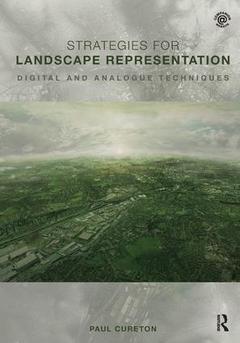Strategies for Landscape Representation Digital and Analogue Techniques

Strategies for Landscape Representation discusses a variety of digital and analogue production techniques for the representation of landscape at multiple scales. Careful consideration is required to represent time, and to ensure accuracy of representation and evaluation in the landscape.
Written as a guide for making appropriate selection of a wide variety of visualisation tools for students and built environment professionals with an interest in landscape, the book charts emerging technologies and historical contexts whilst also being relevant to landscape legislation such as Building Information Modelling (BIM) and Landscape Assessment. This book is an innovation-driven text that encourages readers to make connections between software, technology and analogue modes. The management, choice and combination of such modes can arguably narrow the unknown of landscape character, address the issues of representing time and change in landscape and engage and represent communities? perceptions and experience of landscape.
Showcasing international examples from landscape architecture, planning, urban design and architecture, artists, visualisers, geographers, scientists and model makers, the vitality of making and intrinsic value of representational work in these processes and sites is evidenced. An accompanying companion website provides access to original source files and tutorials totalling over a hundred hours in mapping and GIS, diagrams and notation, photomontage, 3D modelling and 3D printing.
Introduction: Representation, Agency and Valence, 1. Working with Data (Mapping), 2. Landscape, Participation, Notation and Fieldwork (Notation and Diagrams), 3. Time in Landscape (Composites), 4. Strategies for Representation (3D Models), 5. Landscape Modelling & Fabrication (Models), Conclusion: Future Landscapes
Paul Cureton is a Senior Lecturer in Architecture and Unit Leader for Future Cities at the University of Hertfordshire, UK, Member of the Herts UAV Group, Researcher for the International Garden Cities Institute and Researcher for HS2LV at Birmingham City University, UK. He holds a PhD in Landscape Architecture Representation from the Manchester School of Architecture, UK. Primary research interests include GIS, UAVs, mapping, modelling and digital fabrication.
Date de parution : 07-2017
17.4x24.6 cm
Disponible chez l'éditeur (délai d'approvisionnement : 14 jours).
Prix indicatif 271,33 €
Ajouter au panierDate de parution : 12-2016
17.4x24.6 cm
Thèmes de Strategies for Landscape Representation :
Mots-clés :
Choreographing landscape representation; visualisations; emergent workflows; emerging technologies; visual communication; GIS; cloud data; BIM for landscape; Sony Computer Science Laboratories; Cureton Paul; James Corner Field Operations; NURBS Surface; Landscape Architectural Representation; Digital Fabrication; LiDAR Data; Welwyn Garden City; Repeat Photography; Louis De Soissons; Landscape Representation; Space Syntax; Visual Impact Assessments; Data Sets; Atelier Bow Wow; MIT Archive; RSVP Cycle; Photogrammetric Point Clouds; Sky Portals; Bare Earth Digital Terrain Model; Perspective Composites; Water Carpet; Diana Balmori; Regulated Flood Plain Development; Denali National Park; UK Guidance



